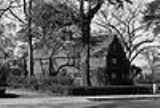
John Whipple House
Encyclopedia
The John Whipple House is a historic colonial house and National Historic Landmark
in Ipswich, Massachusetts
. Built in the seventeenth century, the house has been open to the public as a museum since 1899.
test estimated that the earliest surviving part of the house was actually built in 1677.
Currently, the house is run by the Ipswich Historical Society. The house features oak, pine and chestnut framework. The house was sold several times and used as housing for mill workers in the late nineteenth century. In 1898 the Ipswich Historical Society purchased the house, restored it, and opened it as a museum and headquarters the next year. The house was later moved from its original downtown location on Market and Saltonstall Streets to its present location. In 1953 the current gable
s and casement windows were re-added to the structure as part of another extensive renovation. The John Whipple House was added to the National Register of Historic Places in 1966.
National Historic Landmark
A National Historic Landmark is a building, site, structure, object, or district, that is officially recognized by the United States government for its historical significance...
in Ipswich, Massachusetts
Ipswich, Massachusetts
Ipswich is a coastal town in Essex County, Massachusetts, United States. The population was 12,987 at the 2000 census. Home to Willowdale State Forest and Sandy Point State Reservation, Ipswich includes the southern part of Plum Island...
. Built in the seventeenth century, the house has been open to the public as a museum since 1899.
History
The oldest portion of the farm house was allegedly built around 1642 possibly for John Fawn and sold shortly after to Captain John Whipple, a British soldier and entrepreneur (some speculated that Fawn may have built the house as early as 1638). A large addition to the house was purportedly constructed later in the seventeenth century. In 2005 a dendrochronologyDendrochronology
Dendrochronology or tree-ring dating is the scientific method of dating based on the analysis of patterns of tree-rings. Dendrochronology can date the time at which tree rings were formed, in many types of wood, to the exact calendar year...
test estimated that the earliest surviving part of the house was actually built in 1677.
Currently, the house is run by the Ipswich Historical Society. The house features oak, pine and chestnut framework. The house was sold several times and used as housing for mill workers in the late nineteenth century. In 1898 the Ipswich Historical Society purchased the house, restored it, and opened it as a museum and headquarters the next year. The house was later moved from its original downtown location on Market and Saltonstall Streets to its present location. In 1953 the current gable
Gable
A gable is the generally triangular portion of a wall between the edges of a sloping roof. The shape of the gable and how it is detailed depends on the structural system being used and aesthetic concerns. Thus the type of roof enclosing the volume dictates the shape of the gable...
s and casement windows were re-added to the structure as part of another extensive renovation. The John Whipple House was added to the National Register of Historic Places in 1966.

